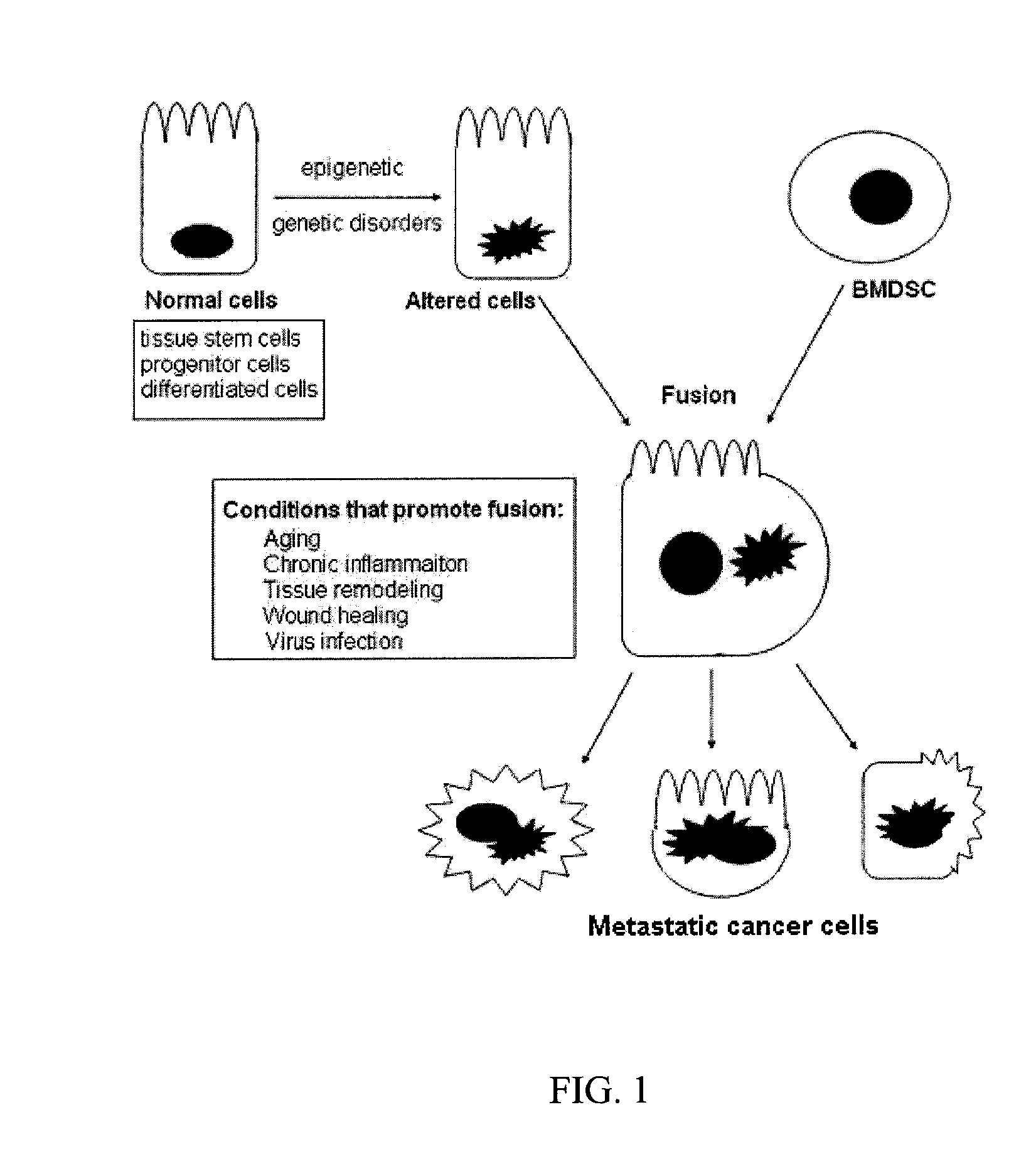Stem Cell Fusion Model of Carcinogenesis
a stem cell and carcinogenesis technology, applied in the field of stem cell fusion model of carcinogenesis, can solve the problems of difficult treatment of cancer, inability to fully address the causes of cancer distinctive features, and failure of gene mutation hypothesis to explain many important features of cancer
- Summary
- Abstract
- Description
- Claims
- Application Information
AI Technical Summary
Benefits of technology
Problems solved by technology
Method used
Image
Examples
experiment 1
[0049]Group A: 8 transgenic mice
[0050]Heterozygous transgenic eGFP mice [C57BL / 6-TgN (ACTbEGFP)1Osb] (Jackson Laboratory) are used as a source of GFP labeled bone marrow cells. GFP mice are identified by expression of green fluorescence under UV light. 2- to 4-month old female heterozygotes are used as the donors for the BMT. Donor's gender is different from that of the recipient host.
[0051]Bone marrow derived cells are obtained from heterozygous GFP mice by flushing the femur and tibia with Hanks' balanced solution. To generate somatic cell hybrids, 106 bone marrow-derived cells and 106 tumor cells are plated on 60 mm dishes 24 hours before treatment with polyethylene glycol (PEG). 5 grams of PEG with a molecular weight of 3000-3700 is prepared by autoclaving for 5 minutes at 121 degrees C. The autoclaved PEG is then combined with 5 ml of 2× sterile serum-free medium, pre-warmed to 37 C to prepare a 50% solution. One ml of the 50% PEG solution per dish is then added slowly to the c...
experiment 2
Altered Tumorigenicity and Progression of Mouse and Human Benign Tumor Cells
[0053]Mice are inoculated with GFP-labeled bone marrow cells, singly or in combination with transformed benign human or mouse cells.
[0054]Group A: 72 mice. Strains: Athymic nude mice for 308 cells; SCID for DU145 or PC-3 M tumors (Pain category D). Total mice needed: (4 mice / treatment) (6 treatments) (3 experiments)=72 mice.
[0055]Mice are inoculated with GFP-labeled bone marrow (BM)-derived cells and / or with transformed benign human or mouse cells. Tumor inoculations are performed on mice anesthetized with isofluorane in a bell jar. The mice are placed in the jar which contains isofluorane treated cotton balls inside a polypropylene centrifuge tube. During the procedure the mice are monitored by observing respiratory rate, movement, muscle relaxation, and lack of directed movement. After inoculation, mice are returned to their cages and monitored until they regain normal consciousness.
[0056]100 ul of PBS con...
experiment 3
Inhibition of Tumorigenicity or Progression
[0062]Mice are inoculated with metastatic transformed human (PC3-M) or mouse (308 10Gy5 or 4T1) cells, and with inhibitors of the CRCX4 receptor. Total mice needed: (4 mice / treatment) (3 treatments) (3 timepoints of administration) (3 experiments)=108 mice.
[0063]Tumor inoculations are performed on mice anesthetized with isofluorane in a bell jar. The mice are placed in the jar which contains isofluorane treated cotton balls inside a polypropylene centrifuge tube. During the procedure the mice are monitored by observing respiratory rate, movement, muscle relaxation, and lack of directed movement. After inoculation, mice are returned to their cages and monitored until they regain normal consciousness.
[0064]100 ul of PBS containing 104 4T1 cells is administered injected into a mammary fat pad of 4 Balb / c mice. The athymic nude mice receive 100 ul of PBS containing 1×106 308 10Gy5 cells. The SCID mice receive 100 ul of PBS containing 1×106 PC-3...
PUM
| Property | Measurement | Unit |
|---|---|---|
| concentrations | aaaaa | aaaaa |
| concentrations | aaaaa | aaaaa |
| concentrations | aaaaa | aaaaa |
Abstract
Description
Claims
Application Information
 Login to View More
Login to View More - R&D
- Intellectual Property
- Life Sciences
- Materials
- Tech Scout
- Unparalleled Data Quality
- Higher Quality Content
- 60% Fewer Hallucinations
Browse by: Latest US Patents, China's latest patents, Technical Efficacy Thesaurus, Application Domain, Technology Topic, Popular Technical Reports.
© 2025 PatSnap. All rights reserved.Legal|Privacy policy|Modern Slavery Act Transparency Statement|Sitemap|About US| Contact US: help@patsnap.com


